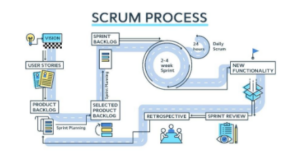Agile and Scrum methodology often get confused as they are both methods used in project management, and both help guide your project to completion. Agile is used to outline the specific philosophy used in project management which follows basic guiding principles. Scrum is a particular type of project methodology that adheres to the Agile philosophies.
Scrum and Agile are used to collaborate team decisions throughout a project. Both use an iterative process and constant client feedback along with the project management procedure. They often get confused with each other; however, Agile and Scrum refer to two different things.
This is an overview of Agile vs. Scrum, their similarities, differences, and when best to use which one.
What Is Agile?
The Agile project philosophy is a repetitive framework for project managers to follow to complete the project at hand. Agile is a specific project management system that consists of a few basic principles. The main goals that Agile focuses on are interactions, customer collaboration, and responding to change.
The Agile Approach believes in continuous communication with the clients throughout the project process to be altered throughout the process. It is an iterative approach often used in software development that allows for changes throughout the project cycle.
Broadly speaking, Agile methodology focuses on iterative development. Agile uses user feedback to adapt project demands throughout the process. In an Agile methodology, members of cross-functional teams work together to develop different solutions in the evolution of the project.
Benefits of Agile
Agile is specifically beneficial for software development. The process of Agile promotes teamwork and leadership within a project team. Agile also is beneficial in allowing systematic analysis of a project and modifications.
Following the Agile philosophy will permit the rapid completion of a project while ensuring a high-quality end result. Another benefit of Agile is that both company goals and client demands can be met. Ultimately, using an Agile methodology will optimize project workflow.
Another benefit of using the Agile philosophy is that the project does not need to be completely defined as ideas may change throughout the project process.
An Agile philosophy will benefit the customer because team members will be more responsive to frequent suggestions. In addition, the development team will benefit as well from continuously seeing their work and better organization as well.
What Is Scrum?

Scrum is a type of project management that follows this Agile methodology. During Scrum project management, a project follows a process in which the work is divided into specific tasks, assigned to specific people, and is each given an order as to when each task needs to be completed.
When following a Scrum project management strategy, there is a team lead assigned by a project manager as well as other specific roles. There is a product wonder, a Scrum Master, and other team members to follow the management strategy. The Scrum Master is responsible for ensuring the rest of the team follows the specific Scrum methodology.
There are multiple different stages known as “Scrum sprints” throughout the Scrum methodology, each focusing on one part of the project. During a sprint, team members work together to complete one portion of the project and to deliver it to the client to be reviewed. Once one sprint of the project is realized, the team will focus on the next portion of the project and so on.
Benefits of Scrum
In a Scrum methodology, one main benefit is that the project is being completed step by step. In doing so, each portion of the project can be analyzed and reviewed in smaller pieces rather than handing in a project to a client altogether. The client can then see the project’s potential throughout its operations and will not have to wait until the end.
Main Differences: Agile vs. Scrum
There are a few key differences between Agile and Scrum that will be reviewed.
Firstly, Agile is a philosophy of project management, whereas Scrum is a specific methodology that follows Agile.
There is also a difference in the team members involved. Agile project management uses members from multiple teams to complete tasks, whereas Scrum has identifiable and specific roles and titles for each role.
Lastly, Agile delivers the entire project to the client at the end of the project, and Scrum focuses on small sprints to hand into the client throughout the process.
How to Use Agile-Agile Frameworks
The idea behind the Agile framework was to be used for software development projects and is particularly helpful in these types of projects. However, Agile may also be used for different types of projects as well depending on the project requirements.
When you are using Agile, each team member’s decisions should be guided by a few key principles for every step of the project development process. Below are the twelve Agile principles to follow when using this methodology:
- Our highest priority is to satisfy the customer through early and continuous delivery of valuable software (or whatever else you deliver).
- Welcome changing requirements, even late in development. Agile processes harness change for the customer’s competitive advantage.
- Deliver projects frequently, from a couple of weeks to a couple of months, with a preference for the shorter timescale.
- Coordinating team members must work together daily throughout the project.
- Build projects around motivated individuals. Give them the environment and support they need and trust them to get the job done.
- A face-to-face conversation is the most efficient and effective method of conveying information to and within different teams.
- The final product is the primary measure of progress.
- Agile processes promote sustainable development. All stakeholders should be able to maintain a constant pace indefinitely.
- Continuous attention to technical excellence and good design enhances agility.
- Simplicity—the art of maximizing the amount of work not done—is essential.
- The best architectures, requirements, and designs emerge from self-organizing teams.
- At regular intervals, the team reflects on how to become more effective, then tunes and adjusts its behavior accordingly.
If you are using an Agile methodology, a specific process will be followed that adheres to the founding principles of Agile. This project process involves six distinct steps:
1. Project Planning
Before you begin working, your team will need to plan out the project at hand. All members should understand the end goal of the project, what the client is looking for, and how this project will be achieved.
2. Creating a Roadmap
In this step of the process, the project will be broken down into each specific feature to come together for the end result. During this step, you will also create a product backlog outlining the specific features that will create the end product.
3. Planning Release Dates
Before beginning the project, you will plan out when each feature of a project will be released.
4. Planning Each Sprint
At the beginning of each phase or sprint, there needs to be a complete understanding of what needs to be achieved at the end of each sprint. This includes what members will be working on which tasks for this sprint.
5. Daily Reviews
Short daily meetings should be held throughout this process so that each team member can overview their work throughout each sprint.
6. Sprint Review
At the end of each sprint, the product will be delivered to the client. At this point, you will also discuss and review the previous sprint and what can be changed for the next portion of the project.
The end goal of using the Agile philosophy for your project development is to allow frequent review of the project process and allow for changes throughout.
When to Use Scrum
To determine whether Scrum is the right methodology to use for your project, you must look at the details of your project at hand. If the project is likely to change throughout the process and would benefit from continuous analysis, then using Scrum may be a great choice.
If you are considering using Scrum, you will also want to look at the technical skill of your team members so that each Scrum role will be executed properly and the methodology will work properly. The team members have to work well together to focus on each sprint collectively to deliver at the end of each due date.
Additional Tips
When transitioning into an Agile methodology, the project management team members must be clear in their specific roles and tasks to ensure the project runs smoothly. Use each daily review and final sprint review meetings to analyze each member’s ability to get the tasks completed and monitor their workload.
Tracking and documenting members’ success will be beneficial for them to see how the process is working.
The concept of Agile needs to be well understood by team members so they can collaborate throughout the process; if used correctly, this philosophy can lead to a more smooth-running project management process.



